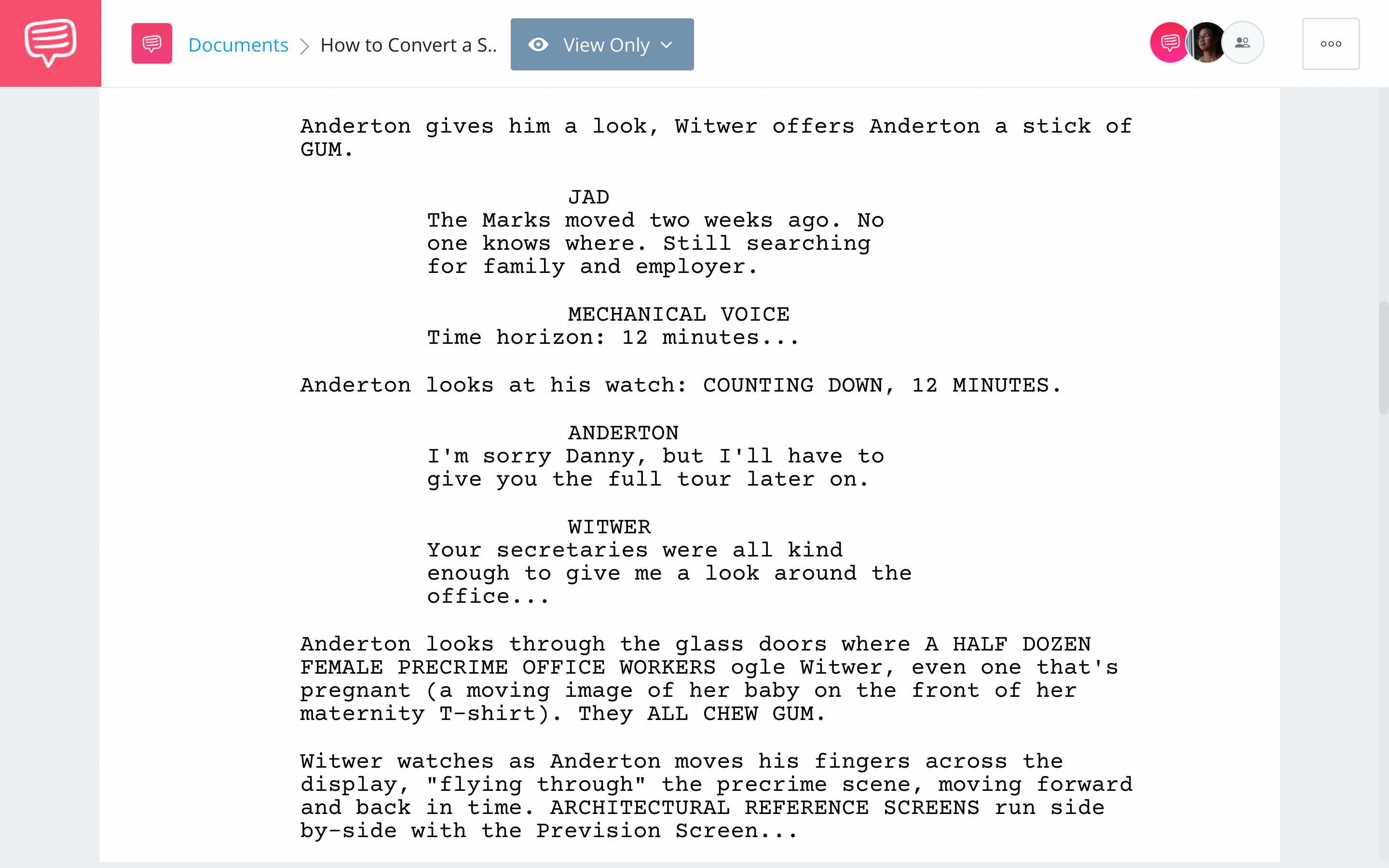Did you know that some of the most famous movies of all time, like Rear Window, Rashomon, and 2001: A Space Odyssey, were adapted from short stories? The art of turning prose into a professional script has been incredibly lucrative for hundreds of writers over the years. We’re going to show you how to convert a short story into a script. By the end, you’ll be ready to pitch the next big cinematic adaptation to studio execs.
Getting Started
1. Always start with organization
So you're ready to turn a short story into a script! The first thing you’re going to need is a copy of the story — duh. But not just any copy of the story, your own copy of the story. That paper should be creased, crinkled, and cropped into smithereens with notes.
Make sure to assign each character in the story a color. Every time they’re mentioned, highlight them in their designated color. This will help you to differentiate them from each other. If at any time a character seems dispensable, then consider eliminating them from the story.
Ask yourself: what purpose did they serve? If they were needed, print out a new copy of the story and start again. This next video will show you how to game plan your script production in further detail.
How to Convert a Story Into a Script by Anna Akana
It may seem redundant to say, but organization is absolutely essential with a process like turning a story into a script. By understanding the importance of organization early on, we’ll be more equipped to handle roadblocks later in the production process.
Approaches
2. Adaptation vs. conversion
Here’s where things start to split. If you’re adapting a short story, then you’re obviously going to want to get in touch with the publisher, author, and or rights holder. This can be a difficult task, but it’s not impossible.
If you’re converting your own story into a script, then consider bringing it to a writing workshop. There are tons of different ways to find workshops, both in person and online. Just search for writing workshops either in your local area or by genre.
No matter whether you’re adapting an existing short story or converting your own, you’re going to need to know the industry standard formatting guidelines for screenwriting. This next video will show you everything you need to know about how to properly format a screenplay:
How to Turn a Story Into a Screenplay • Subscribe on YouTube
Make sure to bookmark this video so that you have it at-the-ready in case any questions come up during the writing process.
Related Posts
Study Up
3. Learn from professionals
Want to see this process in motion? Let’s take a look at a short story that was converted to a script. This is an excerpt from Witwer’s introduction in Philip K. Dick’s "The Minority Report":
“The first thought Anderton had when he saw the young man was: I'm getting bald. Bald and fat and old. But he didn't say it aloud. Instead, he pushed back his chair, got to his feet, and came resolutely around the side of his desk, his right hand rigidly extended. Smiling with forced amiability, he shook hands with the young man.”
"Witwer?" he asked, managing to make this query sound gracious. "That's right," the young man said. "But the name's Ed to you, of course. That is, if you share my dislike for needless formality." The look on his blond, overly-confident face showed that he considered the matter settled. It would be Ed and John: Everything would be agreeably cooperative right from the start.”
The dialogue in this interaction is mostly benign. All of Anderton’s jealousy is implied in the descriptions.
We imported The Minority Report script into StudioBinder's screenwriting software to see how Scott Frank adapted Witwer’s introduction. Pay attention to how the dialogue verbalizes the conflict that’s communicated through descriptions in Philip K. Dick’s story.
How to Convert a Short Story into a Script • Read The Minority Report Excerpt
What can we learn from the difference between The Minority Report short story and script? To answer that question, let’s start with highlighting the characters. Ask yourself what they want, and what prevents them from getting it. Then determine the best way to show conflict. Is it through descriptions, actions, or dialogue?
Depending on the medium, the answer might be different. Clearly Scott Frank went in a different direction than Philip K. Dick did, but both versions essentially boil down to the same thematic crux and conflict.
Start Writing
4. Craft a draft
Now it’s time to put pen to paper — or should I say, finger to keyboard. At this point, don’t get too hung up on formatting mistakes.
Consider using StudioBinder’s storyboard creator to sketch together how your story might look. You don’t need to be Rembrandt to draw storyboards, you just need an imagination. This video will show you everything you need to know to get started:
How to Turn a Short Story Into a Script • Subscribe on YouTube
Remember, the reason for converting a story into a script is so that it will eventually become visual. It’s helpful to imagine how these characters might look in a final production.
You’ve probably heard that some authors aren’t fond of the cinematic adaptations of their books. One reason for this is that most of the time, their 300+ page books are cut down to 120 page scripts. A lot can be lost in translation within those pages.
Conversely, many authors prefer that their short stories are turned into films. Short stories are inherently more focused, and more succinct than novels. As a result, they often rely on fewer themes, but are just as rich, if not richer in subtext. The reality of writing a short story is that you can only fit so much into 5-15 pages. For the story to be nuanced, it needs to rely on all the things communicated between the lines.
The job of the writer who’s adapting a short story to a feature-length screenplay is to expound and expand upon its hidden meaning.
If you’re adapting a short story into a short film, then the goal is to bring the words to life through visuals.
With all of this in mind, you’re ready to draft a script. As you’re going through the process, review some script teardowns. In these articles, we break down different components of movie scripts, so that you can see what works, and what doesn’t work in some of the most popular movies of all-time.
Rewriting
5. Review your work
Once your script looks like it’s in good shape, then you’re going to want to get some feedback. If you joined a workshop earlier in the process, consider sharing your script. You never know who might be interested in producing or collaborating on the project.
Worst things worst, you’re going to hear what others think — which is never a bad thing when trying to get a project off the ground.
Now that everything’s finalized, you may want to enter a screenwriting contest or submit to a festival. Whatever you choose to do, just know this: you’ve become a better writer by going through the process of turning a short story into a script.
UP NEXT
How to write a script like a professional
If you’re serious about being a professional screenwriter, then you have to read our article on how to write a movie script like the pros do. We touch on everything that you need to know, from font size/type to outlining story beats. By the end, you’ll be ready to apply advanced screenwriting techniques into your own script.

